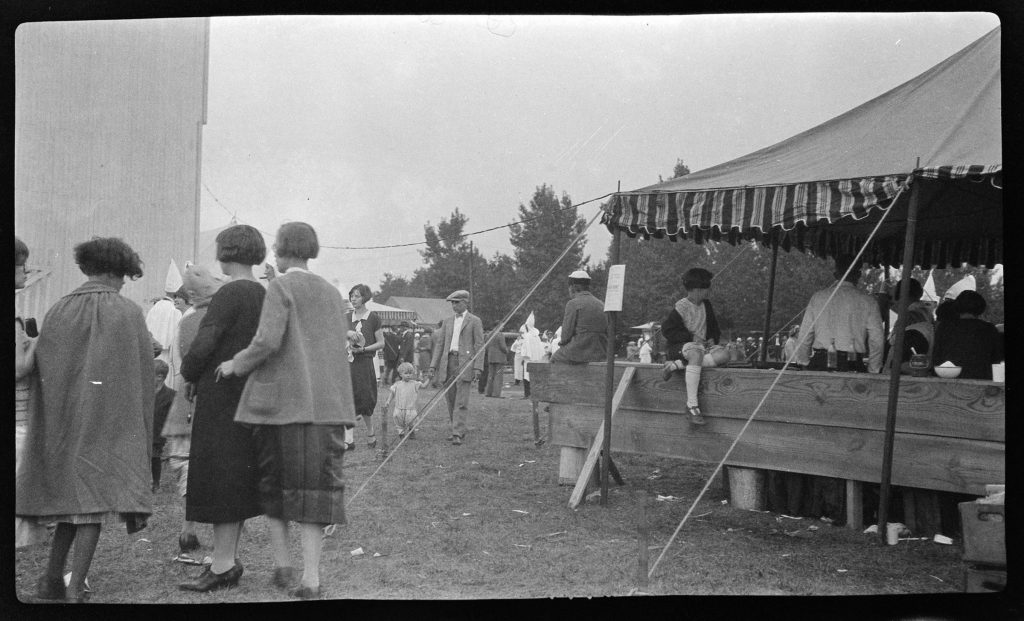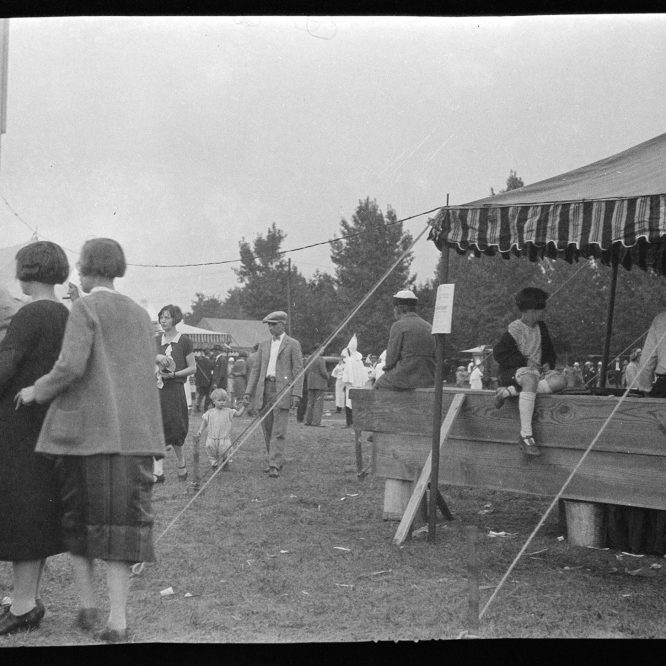Vol. 4, No. 51
This photograph, taken September 7, 1925, shows the Western New York Province 8 Klonverse held at the Orleans County Fairgrounds on the western end of the Village of Albion. The term klonverse is likely foreign to most readers, as it should be, since the term was used to describe a convention of the Knights of the Ku Klux Klan.
Pulled from a collection of negatives within the Department of History, the photograph shows a number of robed men intermingled within the crowd at the conclusion of a parade through Albion. Papers throughout Western New York published news of the impending gathering, the Buffalo Evening News noting that this particular meeting was the first of its kind in Orleans County.
Chester Harding, president of the Orleans County Agricultural Society rented the fairgrounds to the Klan for $100 “…and considerable criticism [was] heard of the action,” and Hiram Wesley Evans, Imperial Wizard of the Knights of the Ku Klux Klan from Atlanta, Georgia, was scheduled to headline the festivities. Local members of the Klan applied for the parade permit and village officials barred any Klansmen from marching with their faces covered; state police and local officers were present to keep the peace.
The parade of approximately 900 members commenced at 5 o’clock in the afternoon and a modest crowd of 500 gathered to watch the procession. Three bands and two floats escorted Klan members, all adorned in their white robes, as they processed through the streets. Residents who lined the streets to observe the spectacle did so out of curiosity, either never seeing a Klan parade before or hoping to catch a glimpse of the unmasked participants. As the parade reached the fairgrounds, only members and those with cards given to them by members were permitted to enter the event; a $.25 entry fee was charged. National and state organization leaders spoke to members in the evening, preceded by the burning of a massive cross and induction of new members into the Klan.
Aside from the shocking nature of such a meeting, a Buffalo resident by the name of Julius Grass stirred up extra commotion at the conclusion of the parade. Losing control of his automobile, Grass struck Nelson Spears of Middleport and 68-year-old Melvin Waterbury of Lyndonville. Perhaps more interesting than the accident itself was the mention in the paper that both victims were Klansmen, the only mention of any local member of the organization by name. Waterbury suffered a concussion and Spears a broken leg.
Bill Lattin wrote an article about this same event in Bethinking of Old Orleans (v. 14, no. 35, 1992) and concluded his story by writing, “very little is known of the organization locally.” Such statement appears to be true, but a relatively limited history of the Ku Klux Klan is discernable from local papers despite the secret nature of the organization.
On May 15, 1924, the Medina Tribune noted the intent of men in Lyndonville to organize a Klan in that area (the word Klan was used to describe a local “chapter”). Nearly three months later, a large KKK float participated in a festival parade in Lyndonville organized by local Masons. Members mounted the float with placards on which the objectives of the organization were printed. The Medina Daily Journal noted that “this [was] the first public appearance of the Klan in connection with a community celebration in this section of the state.”
Early Klan activity was limited to residents traveling to Genesee County, where they participated in activities in those areas. Evidence does suggest that the Klan was active enough in certain townships to support political candidates. Several months after the Klonverse, local papers printed the results of local elections in which Ross Hollenbeck defeated Fred H. Rhodey for Sheriff of Orleans County. The Buffalo Evening News ran this story with the headline, “Klan Candidate for Sheriff Assured of Election by 3200 Votes.” Klansmen in several towns offered their support to Hollenbeck in the months leading up to the election, suggesting that this particular gathering in September may have increased local activity.
Many will be surprised to read that the Ku Klux Klan was active in Orleans County, although the exact extent of that activity is unknown. The Second Ku Klux Klan, in addition to violence directed towards minorities and immigrants, focused on upholding Prohibition and fighting moral wrongs such as adultery and divorce. A series of events impacting the Klan in other states contributed to a sharp decline in membership and thus local activity would die out by the 1930s.


